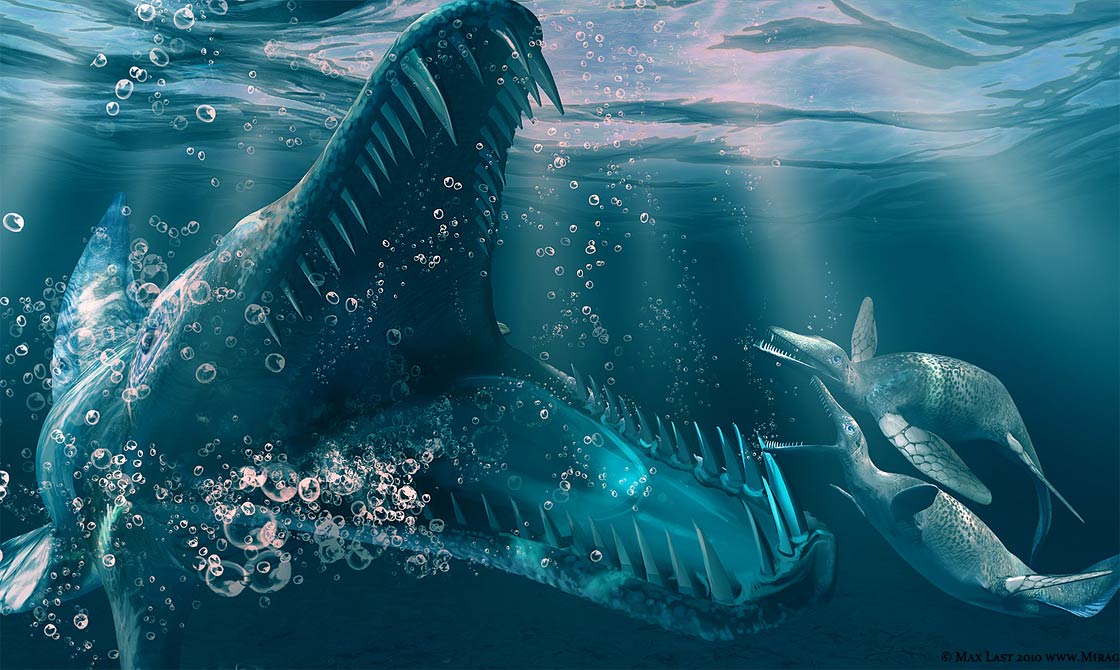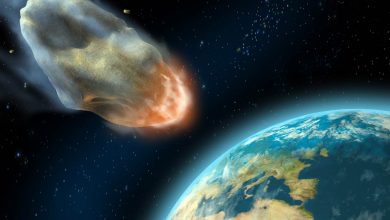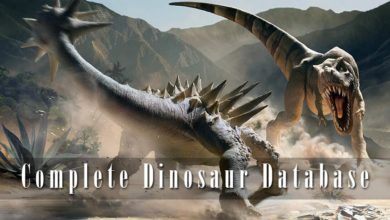Kronosaurus – one of the largest pliosaurs
Kronosaurus – one of the largest marine reptiles
Considered one of the largest and cruelest marine reptiles, its name is associated with the Greek titan – Kronos. He was the king of his time, no other aquatic predator could match him. At that time, there was no king of the seas and oceans of all time – Megalodon…
Classification
- Kingdom: Animalia
- Phylum: Chordata
- Class: Reptilia
- Superorder: †Sauropterygia
- Order: †Plesiosauria
- Family: †Pliosauridae
- Subfamily: †Brachaucheninae
- Genus: †Kronosaurus

Dating, occurrence and discovery
Kronosaurus ruled in the early Cretaceous (about 112 million years ago) in the shallow epicontinental seas of present-day Australia and Colombia. The animal was known in 1899 thanks to Andrew Crombie from Hughenden (Australia, Queensland), who discovered a piece of bone containing 6 conical teeth. The discovery was given to the Museum in Queensland, and after 25 years, the then director of the museum – Heber Longman – created an official description of the fossil as a new species: Kronosaurus queenslandicus.
More skeletal elements (incomplete skull) were unearthed in 1929, at the same site where the first discovery was made. Three years later, an expedition of paleontologists from Harvard University, led by William E. Scheville, provided tons of fossil material in the form of an almost complete skeleton. It took scientists another 20 years to prepare and assemble the silhouette of a Kronosaurus because there was not enough money to restore the find.

Characteristic
Like other pliosaurs, the Kronosaurus was a marine reptile but not a dinosaur.
The head of the Kronosaurus was elongated, the neck was short, and the less mobile torso was driven by 4 fins and a relatively short tail. The hind fins were longer than the front ones. The animal led a carnivorous lifestyle – as evidenced by its long, sharp, conical teeth. Like all “lizard flippers” (Sauropterygia), it had a modified rim on the forelimb – its task was to control its powerful fins. He also had abdominal ribs to strengthen the skeleton while swimming.
The strong structure of the limb girdles and evidence of large swimming muscles indicate that the Kronosaurus was a fast and active animal.

Size
The length of the body, based on the dimensions of the reconstructed skeleton, could have been as high as 12.8 m (42 ft), but recent studies comparing the Kronosaurus with other Pliosaurs suggest that the reconstructed reptile has too many vertebrae, leading to an overestimated body length. Ultimately, it was found that it measured 9-11 m (30 – 36 ft).
Teeth
The teeth at the back of the jaw were strong enough to crush shells and the then cephalopods (calamari, octopus). They were different in structure from the teeth of other Pliosaurs: they were not serrated and did not consist of three sides.
The size of the teeth may indicate that – despite its large size – the reptile hunted small or medium-sized animals so that it could swallow them whole. In the case of larger prey, thanks to the strength of his jaws, he sank his teeth into the victim’s body to tear off a large chunk of meat by turning his body around its axis (similar to today’s crocodiles).

Diet
It ate on ammonites and other cephalopods. Fossil remains of plesiosaurs and turtles were found in his abdominal cavity. Strong and sharp teeth with rounded crowns on the back of the jaw were adapted to breaking shells and seashells. It is possible that he also hunted large squids, but that is not certain.
On the skull of one of the Australian Elasmosaurus – Eromangasaurus – rounded tooth marks that may belong to Kronosaurus have been discovered, and the mere fact that Eromangasaurus is known only from this skull, may suggest that the head was torn off by our Kronosaurus during the attack.
The way of obtaining food and guesses about the way of life show great similarities to the great white shark (Carcharodon carcharias), which absorbs everything that comes on its way.

Detailed data and dimensions (size)
Kronosaurus
- Body length: 9 – 11 meters (30 – 36 ft). / previously thought to be over 12 meters (40 ft)
- Skull length:7 m (8.85 ft)
- Weight:6 – 12.1 tons
- Teeth: the largest 30 cm (12 in) long with 12 cm (4.7 in) crowns
- Jaw pressure: up to 30,000 Newtons (3,059 kg)
- Occurrence: the seas of South America (today’s Colombia) and Australia
- Period: Early Cretaceous 120 – 100 million years ago (Aptian – Late Albian)

Kronosaurus – interesting facts
- The name of this sea predator comes from the mythological Greek titan Kronos, who ate all his children – except Zeus – to maintain his power. The literal translation of the name may be: “Kronos’ lizard” or “lizard of Kronos”.
- Kronosaurus is recognized as one of the most effective marine predators of the Mesozoic era.
- The teeth of a Kronosaurus were more than 7 cm (2.8 in) long, the longest found tooth was approx. 30 cm (12 in) long, and the crown was approx. 12 cm wide (4.7 in).
- The skull (head) made up 1/3 of the total length of the Kronosaurus body.
- Kronosaurus swam in the open seas and often surfaced to get air. In the abdominal cavities of some specimens, small stones were found that could be used for grinding food or as ballast to facilitate diving.
- The Kronosaurus was larger than the Liopleurodon, which is often considered the largest plesiosaurus in history. There was pliosaur larger than the Kronosaurus – a Svalbard Pliosaur with the “working” name Predator X. Currently, Predator X has been classified as Pliosaurus funkei – its length was 10–13 m (33–43 ft).
- Another potentially longer plesiosaurus could be Pliosaurus macromerus, estimated to be 10-13 (33–43 ft) or even 13-15 meters (43 – 49 ft).
- Brachauchenius, who lived 93.5-89.3 million years ago, was similar in size to the Kronosaurus. Its skull was 170 cm (5.6 ft) long (FHSM VP-321) and as an adult, it was approx. 10 meters (33 ft) long and weighing approx. 10 tons. A more recent estimate is 6 to 9 meters (20 – 30 feet) in length.

Recommended
- Mass extinctions of species – the „Big Five”
- History of animals and plants extinction
- Extinction of dinosaurs. Why are they extinct?
- The longest dinosaurs. Sauropods Top 10
- The heaviest dinosaurs – Top 10
- The longest predatory dinosaurs. Theropods Top 10
- The heaviest predatory dinosaurs Top 10
- The longest Ornithischians (Ornithischia) TOP 10
- The heaviest Ornithischians Top 10
- The largest raptors (dromaeosaurs) Top 10
- The heaviest Dromaeosaurids / dromaeosaurs – Top 10
- The longest Ankylosaurus Top 10
- The heaviest Ankylosaurus Top 10
- The longest ceratopsians
- The heaviest ceratopsians
- The longest and largest ornithopods
- The heaviest ornithopods Top 10
- The longest Stegosaurians (Stegosauria) TOP 10
- The heaviest Stegosaurians (Stegosauria) Top 10
- The smallest sauropods Top 10
- The smallest dinosaurs Top 10
- The largest pterosaurs Top 10
- Dinosaurs
- Dinosaurs database
- Predatory dinosaurs
- Animals & dinosaurs records
- The fastest animals – Top 100
- The fastest birds – Top 10


















